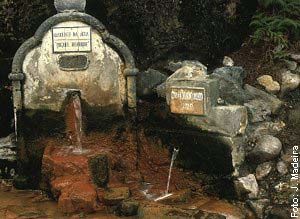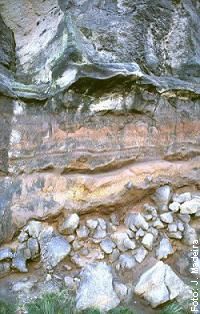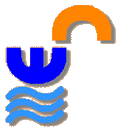|
SEPTEMBER 24th – 29th,
1999
S. Miguel and Terceira Islands
The Azores archipelago, composed of 9
volcanic islands, is located between Europe and America, close to the Mid Atlantic Ridge.
It is a Portuguese territory with the status of Autonomous Region with its own government.
Climate – the climate, maritime
temperate, is mild by the influence of the Gulf Stream, with low thermal amplitudes; in
summer the average temperature is 23º C (73º F) while the maximum temperature reaches
28º C (83º F). Seawater temperatures in summer are 20 to 24º C (68º to 75º F).
Clothing – Usually light clothing will
be enough and a rain protection may be needed due to the possibility of showers; in areas
of higher altitude warmer clothes are advised.
PROGRAMME
Sept. 24th – S. Miguel
Morning - Flight Lisbon-Ponta
Delgada
Afternoon – Town of Ponta Delgada:
visit to the motherchurch, a XVIth century gothic temple with a Manuelino style
façade carved in limestone taken from Lisbon, and to the Gruta do Carvão cave, a lava
tube that crosses the town.
Sept. 25th – S. Miguel
Village of Ribeira Seca –
fountain fossilized by a basalt lava flow during the 1563 eruption;
Village of Ribeira Grande –
motherchurch of the XVIth century;
Água de Pau or Fogo
Volcano: Caldeira Velha – fumarolic lava field in the north slope of the
volcano; visit to the Geothermal Power Plant; view to the volcanic caldera and lake, where
an eruption occurred in 1563;
Village of Vila Franca do Campo
– former capital city of the island, totally destroyed in 1522 by a landslide
triggered by an earthquake, in which 5.000 people died; view to the Vila Franca islet, a
volcanic cone built by a shallow marine eruption prior to the settlement of S. Miguel;
Furnas Volcano
– visit to the caldera and village of Furnas, with its lake and numerous fumaroles
and hot springs, an opportunity to taste the famous Cozido das Furnas (boiled meat and
vegetables) cooked in the ground by the heath of the hydrothermal activity; observation of
trachyte volcanic cones, one of which (Lagoa Seca) formed during the huge 1630 plinian
eruption;
Return to town with a stop in the village
of Lagoa to visit a typical pottery factory.
Sept. 26th – S. Miguel
Sete Cidades Volcano
– view of the volcanic caldera of Sete Cidades from the Vista do Rei (King’s
view) belvedere; visit to the Sete Cidades village and lake inside the caldera;
observation of trachyte volcanic cones;
Fajã dos Mosteiros –
visit to the Mosteiros village, built at sea level on a basalt lava delta; the toponym
"Fajã" means flat area by the sea;
Return to town passing by the villages of Bretanha,
Santo António and Capelas, where the typical rural architecture can be
appreciated;
Free afternoon
– shopping, beach.
Sept. 27th – S. Miguel
and Terceira
Morning – Flight from Ponta
Delgada to Lajes;
Afternoon – guided visit to the town
of Angra do Heroísmo, classified by the UNESCO as World Heritage.
Sept. 28th – Terceira
Guilherme Moniz Caldera
– the road to the central area of the island crosses the inner floor of a volcanic
caldera, partially filled with basalt lava flows from the Algar do Carvão scoria cone;
Algar do Carvão
– cave in a basalt scoria cone formed as the volcanic conduits emptied during the
final stages of an eruption 2.115 years ago;
Furnas do Enxofre –
fumarolic field with extraordinarily developed specimens of primitive plants;
Mistério do Negro –
basalt lava field formed during the 1761 historic eruption; volcanic landscape formed by
basalt lava flows and scoria cones; visit to several lava tubes in the lava flows;
Santa Bárbara Volcano
– ascent to the volcano summit by bus (maximum altitude of the island – 1.021 m
above sea level) to observe the volcanic caldera and trachyte domes that almost fill it;
walk around the caldera rim (depending on the weather conditions) where the characteristic
Macaronesian flora may be observed (Macaronesia is the designation of the central Atlantic
islands);
Return to town passing by the villages of Serreta
(observation of the submarine eruption of Serreta if still active), Doze Ribeiras
and S. Mateus.
Sept. 29th – Terceira
Town of Praia da Vitória –
visit to the motherchurch, gothic style with a Manuelino portal built in the XVth
century by the first governor (Capitão Donatário) of Terceira, and to the original house
of the Capitão Donatário built during the XVIth century (Paços do Concelho);
Serra do Cume belvedere
– view to the inner floor of a 7 km wide caldera filled by young basalt lava flows
and some scoria cones, forming a vast plain occupied with pastures;
Village of Fonte Bastardo –
visit to some caves of the lava tube type in a young basalt lava field;
Village of S. Sebastião –
visit to the gothic church of S. Sebastião and to the village Império do Espírito Santo
(a sort of small chapel build by laic catholic brotherhoods in devotion to the Holy
Spirit);
Village of Feteira - visit to some
caves of the lava tube type in a young basalt lava field, part of which from the Algar do
Carvão eruption; view to the submarine volcanic cone of Ilhéus das Cabras;
Return to town.
Sept. 30th – Terceira
Free morning –
shopping;
Afternoon – flight from Lajes
to Lisboa.
Field Trip Coordinator: J.
Madeira (Univ. Lisboa; SPE)
Regional Coordinator: J. C.
Nunes (Univ. Açores) |

Location of Azores

Lagoa do Fogo: Lake inside summit caldera of
Água de Pau volcano (São Miguel island)

General view of Furnas fumarolic field
(São Miguel island)

Iron rich water from hot springs in Furnas fumarolic field (São Miguel island)

Pero Botelho fumarolic conduit with boiling
mud and vapour emissions (São Miguel island)

Sulfur crystals in Furnas fumarolic field (São Miguel island)

Emptied crater pit of Algar do Carvão scoria
cone (Terceira island)

Lava plain inside Cinco Picos caldera
(Terceira island)

Road cut exposing ignimbrite overlying baked
pumice fall deposits (Terceira island)

Basaltic spindle-shape bombs

"Holy Spirit Chapel" at São
Sebastião
(Terceira island)

Lava tube in basaltic lava flow (Terceira island)
|
